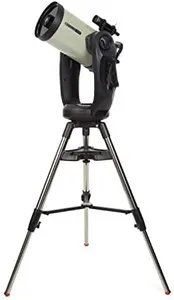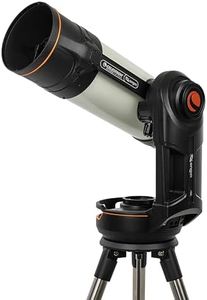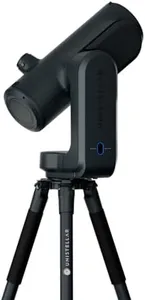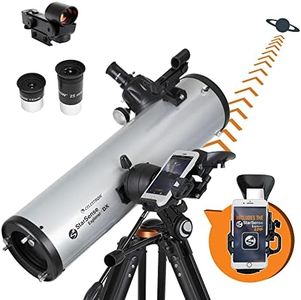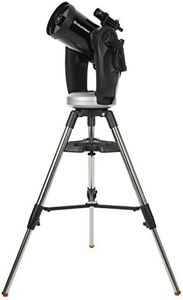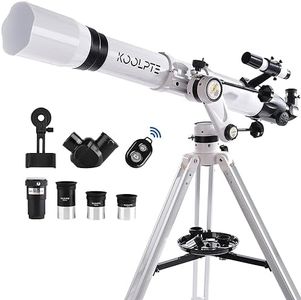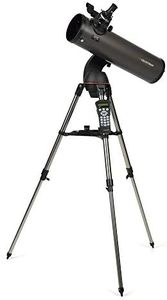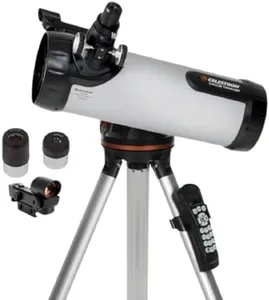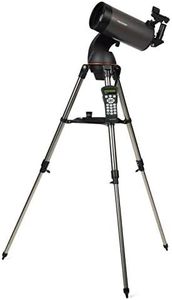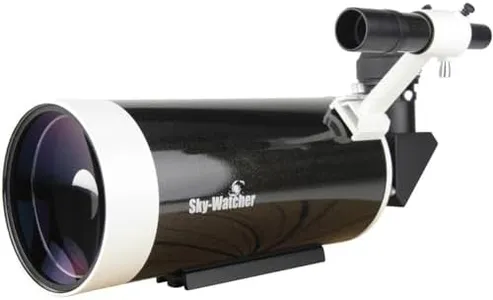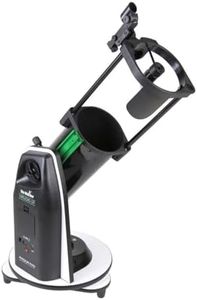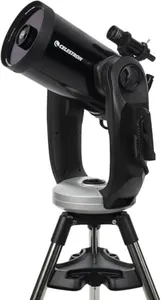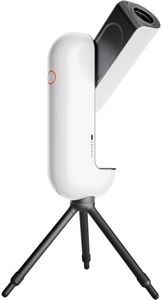10 Best Computerized Telescopes 2025 in the United States
Our technology thoroughly searches through the online shopping world, reviewing hundreds of sites. We then process and analyze this information, updating in real-time to bring you the latest top-rated products. This way, you always get the best and most current options available.

Our Top Picks
Winner
Celestron CPC Deluxe 1100 HD Computerized Telescope
Most important from
32 reviews
The Celestron CPC Deluxe 1100 HD Computerized Telescope stands out with its advanced features and high-quality build. It boasts a substantial 280mm (11-inch) aperture, which allows for excellent light-gathering capability, making it ideal for deep-sky observations. The focal length is substantial, providing high magnification for detailed views of celestial objects. The dual fork arm altazimuth mount is robust and provides superior tracking and pointing accuracy, which is essential for both casual and advanced astronomy sessions.
Additionally, the GoTo system with All-Star Polar Alignment and Programmable Periodic Error Correction enhances its capability for serious astroimaging, ensuring precision and ease of use even for complex setups. The StarBright XLT coatings improve image brightness and light transmission, contributing to clearer, more detailed visuals. However, at 45 kilograms (99 pounds), this telescope is quite heavy and may be challenging to transport, impacting its portability.
This weight factor, combined with manual focus, may not be ideal for those seeking a more portable or beginner-friendly option. The DC power supply requirement ensures that you need a power source nearby, which could be a limitation in remote locations. This telescope is best suited for experienced amateur astronomers who prioritize high-quality imaging and have the setup to accommodate its size and power needs. Its high-end features and larger size suggest it is more tailored toward serious users rather than casual stargazers.
Most important from
32 reviews
Celestron – Origin Intelligent Home Observatory – All-in-one Astroimaging and Stargazing Smart Telescope – 6-inch RASA Telescope – Fully-Automated GoTo Mount – User-Friendly – iOS/Android Compatible
Most important from
28 reviews
The Celestron Origin Intelligent Home Observatory stands out as a great option for both stargazing enthusiasts and budding astrophotographers. With a 6-inch aperture and fast f/2.2 focal ratio, it offers impressive image brightness and clarity, making celestial objects come alive in stunning detail. The patented RASA optical technology enhances its capabilities, allowing for vibrant images with shorter exposure times, which is ideal for capturing fleeting moments in the night sky.
One of the major strengths of the Origin telescope is its automated setup using StarSense technology. This feature scans the sky and aligns the telescope, allowing users to start observing within minutes, making it user-friendly even for beginners. The intuitive app interface for both iOS and Android provides easy navigation of celestial objects, enhancing the experience.
Another notable feature is its AI-powered astrophotography capability. It automatically processes and stacks frames in real-time, significantly reducing the complexity typically associated with capturing high-quality astrophotographs, which can be a huge plus for those who want stunning images without getting bogged down in technical details.
There are a few considerations to keep in mind. Weighing in at 41.6 pounds, this telescope is not the most portable option available, which may limit its use for users looking to take it on the go or for casual, spontaneous stargazing sessions. Additionally, while the automated features are convenient, they might not appeal to users who prefer a more hands-on approach to astronomy.
The Celestron Origin is a strong contender in the computerized telescope category, particularly for those interested in astrophotography and easy-to-use features. Its advanced technology and user-friendly design make it accessible for beginners, though its weight could be a drawback for those seeking a more portable option.
Most important from
28 reviews
Odyssey PRO - UNISTELLAR Smart Telescope (with Eyepiece), 85mm f/3.9 (320mm) Digital & Computerized, App-Controlled Motorized Alt-Az, Enhanced Vision, RAW/FITS Export, 64GB, 5h Battery (Black)
Most important from
36 reviews
The UNISTELLAR Odyssey PRO is a user-friendly computerized telescope designed to make stargazing easy and engaging for both beginners and casual astronomy enthusiasts. It features an 85mm aperture, which is decent for viewing planets, bright galaxies, and nebulae, though it may not reveal the faintest deep-sky objects. The altazimuth mount with automatic star finding and tracking lets you quickly point to and follow celestial objects without manual adjustment, making it very approachable if you’re new to telescopes.
Its standout features include Dynamic Signal Amplification and Multi-Depth Technology, which enhance image brightness and allow you to switch focus between nearby planets and distant galaxies seamlessly. The telescope is quite portable, weighing about 6.5 kilograms (around 14 pounds) and measuring roughly 17” by 8” by 5”, so you can take it to dark-sky locations without too much hassle. It runs on a rechargeable lithium-ion battery, supporting cordless use during your outdoor sessions.
The autofocus feature helps maintain clear views without manual tweaking, enhancing the viewing experience. While the modest aperture size restricts how much detail can be seen compared to larger telescopes, the Odyssey PRO is a compact, smart telescope that gets you observing quickly with minimal setup and crisp views of popular celestial sights.
Most important from
36 reviews
Buying Guide for the Best Computerized Telescopes
Choosing the right computerized telescope can be a thrilling yet daunting task, especially if you're new to stargazing. A computerized telescope, also known as a GoTo telescope, is equipped with a computer system that can automatically locate and track celestial objects for you. This makes it easier for beginners and experienced astronomers alike to explore the night sky. To make an informed decision, it's important to understand the key specifications and how they align with your needs and preferences.FAQ
Most Popular Categories Right Now
